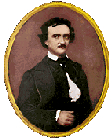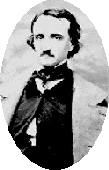 |
Welcome to Salina High School South "The Raven" (1845) |
 |
 |
Welcome to Salina High School South "The Raven" (1845) |
 |
| Once upon a midnight dreary, while i pondered, weak and weary over many a quaint and curious volume of forgotten lore — while i nodded, nearly napping, suddenly there came a tapping, as of some one gently rapping, rapping at my chamber door. "'tis some visiter," i muttered, "tapping at my chamber door — only this and nothing more." ah, distinctly i remember it was in the bleak december; nameless here for evermore.
this it is and nothing more.
darkness there and nothing more.
merely this and nothing more.
'tis the wind and nothing more!"
perched, and sat, and nothing more.
quoth the raven "nevermore."
with such name as "nevermore."
then the bird said "nevermore."
of "never — nevermore."
meant in croaking "nevermore."
she shall press, ah, nevermore!
quoth the raven "nevermore."
quoth the raven "nevermore."
quoth the raven "nevermore."
quoth the raven "nevermore."
shall be lifted — nevermore!
Devices of Sound: Alliteration, Internal Rhyme, Refrain "The Raven" creates a hypnotic effect as it takes readers into the speaker's increasingly irrational world, where the question of what the raven means by its single repeated word seems a reasonable one. To some extent, readers must share that state of hallucination which makes the question meaningful to the speaker. One device of sound that Poe uses to accomplish this hynotic effect is frequent alliteration, the repetition of consonant sounds, usually at the beginning of words: "nearly napping," "ghastly grim," "followed fast." A second device is internal rhyme, rhyme that occurs within a line. For example: "Nothing further then he uttered, not a feather then he fluttered" A third device is the use of a refrain, a phrase or line that is regularly repeated, usually at the end of a stanza. In "The Raven" the concluding line of each stanza is seven or eight syllables long, roughly half the length of the other lines, thereby drawing attention to itself. These final lines are different in content, but they all end with the word more, either alone or in combination. As the poem develops, this refrain accumulates ominous meaning, the variations disappear, and the last word, whether spoken by the raven or by the speaker, becomes insistently Nevermore. The overall effect of these devices is to separate sounds from sense, to lull us into expecting a pattern of sounds that becomes more important than the actual meaning of the words, and thereby to persuade us that the speaker's story may actually be true. For example, line 38 "In there stepped a stately Raven of the saintly days of yore" presents the bird's action (its stepping in) and its appearance (stately), both of which we can accept as fact. But the rest of the line is purely subjective. There is no reason to assume, with the speaker that the bird has come, supernaturally, from a time long past. Nor is there reason to agree that those days were saintly. That past and its "forgotten lore" appear to be the source of the superstitions that dominate the speaker's mind and make him think of the bird as a "prophet" from the land of the dead. it is the alliteration "stepped . . . stately . . . saintly) that makes saintly seem an appropriate word. And "days of yore" has its place in the dominant rhyme-sound of the poem: door, floor, shore, core, wore, more, and so on. This hypnotic pattern of sounds gives the word Nevermore its special significance. As we are drawn into the poem in this way, we come to share the speaker's point of view, and accept his vision as reality.
|
[Biography] | [The Black Cat] | [The Cask of Amontillado] | [The Tell-Tale Heart] | [Annabel Lee] | [The Bells] [Helen] | [Lenore] | [The Raven] | [The Fall of the House of Usher] | [Definition of a Short Story] | [Back Home]